Management Control Systems: Impact on Entrepreneurial Ventures
VerifiedAdded on 2023/06/08
|12
|3510
|181
Essay
AI Summary
This essay critically evaluates the impact of management control systems—cost management, planning, budgets, control and performance, feedback, and scorekeeping—on risk-taking, innovative, entrepreneurial, and expansionist business moves in an era of increased opportunities and competitio...
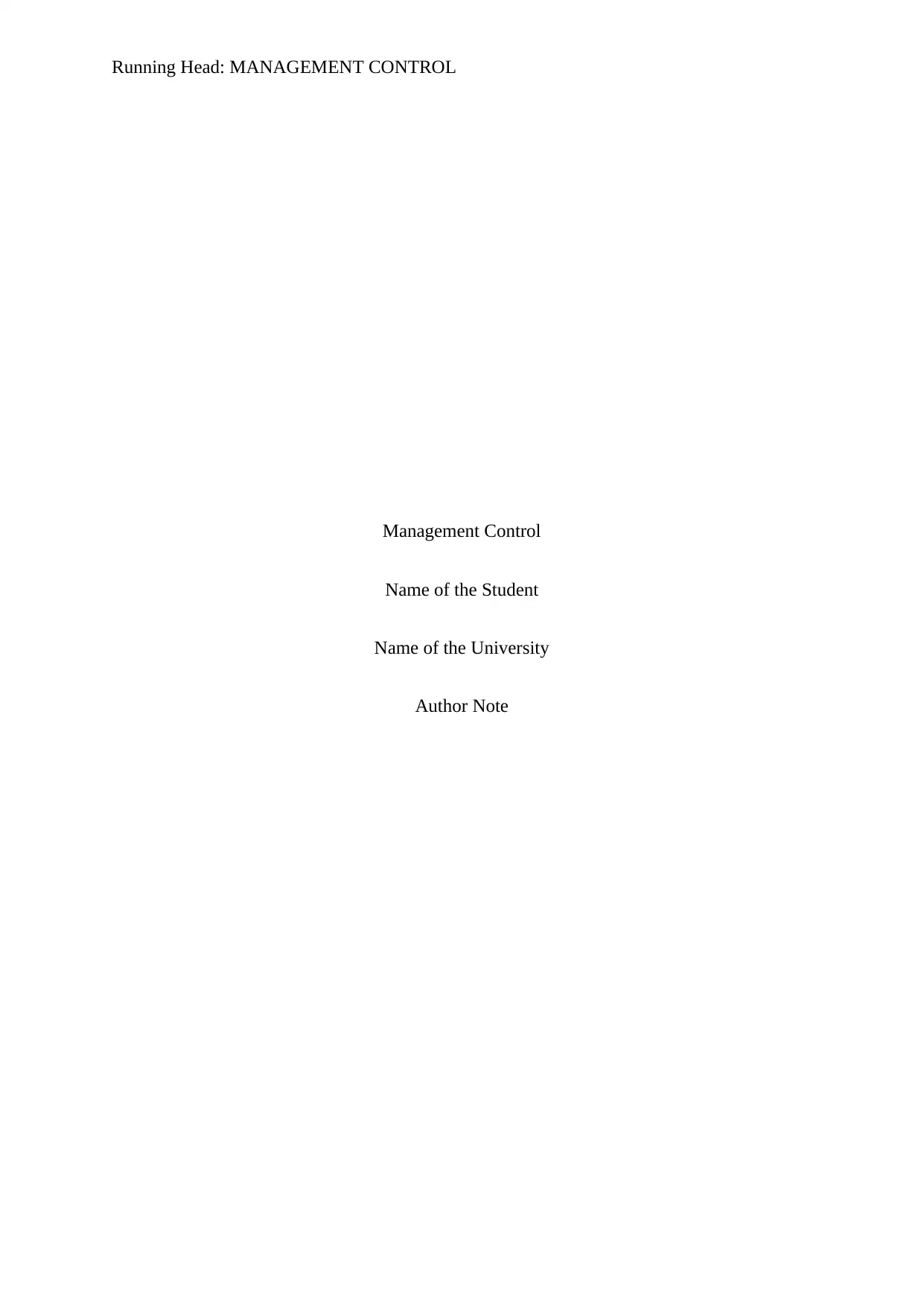
Running Head: MANAGEMENT CONTROL
Management Control
Name of the Student
Name of the University
Author Note
Management Control
Name of the Student
Name of the University
Author Note
Paraphrase This Document
Need a fresh take? Get an instant paraphrase of this document with our AI Paraphraser
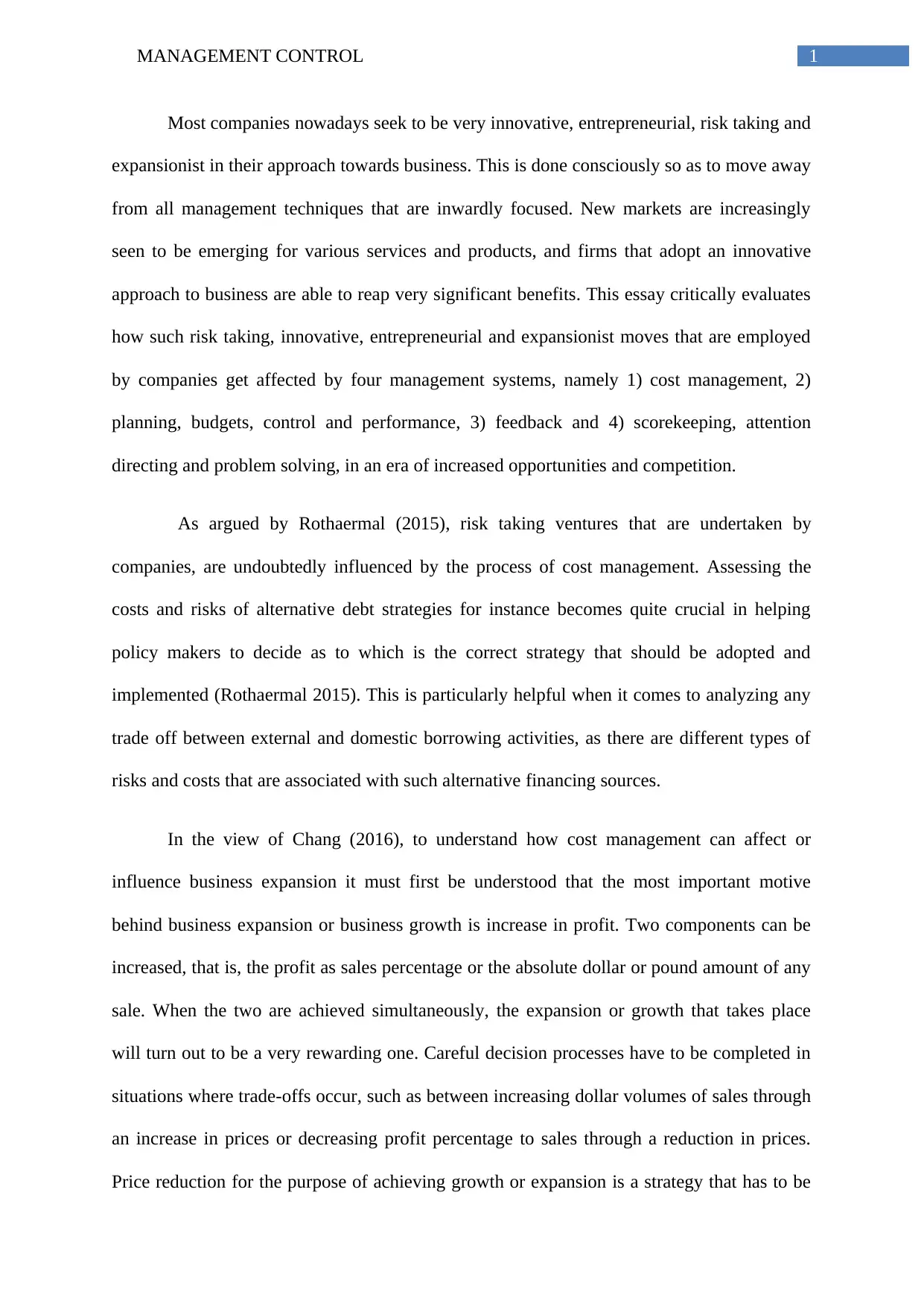
1MANAGEMENT CONTROL
Most companies nowadays seek to be very innovative, entrepreneurial, risk taking and
expansionist in their approach towards business. This is done consciously so as to move away
from all management techniques that are inwardly focused. New markets are increasingly
seen to be emerging for various services and products, and firms that adopt an innovative
approach to business are able to reap very significant benefits. This essay critically evaluates
how such risk taking, innovative, entrepreneurial and expansionist moves that are employed
by companies get affected by four management systems, namely 1) cost management, 2)
planning, budgets, control and performance, 3) feedback and 4) scorekeeping, attention
directing and problem solving, in an era of increased opportunities and competition.
As argued by Rothaermal (2015), risk taking ventures that are undertaken by
companies, are undoubtedly influenced by the process of cost management. Assessing the
costs and risks of alternative debt strategies for instance becomes quite crucial in helping
policy makers to decide as to which is the correct strategy that should be adopted and
implemented (Rothaermal 2015). This is particularly helpful when it comes to analyzing any
trade off between external and domestic borrowing activities, as there are different types of
risks and costs that are associated with such alternative financing sources.
In the view of Chang (2016), to understand how cost management can affect or
influence business expansion it must first be understood that the most important motive
behind business expansion or business growth is increase in profit. Two components can be
increased, that is, the profit as sales percentage or the absolute dollar or pound amount of any
sale. When the two are achieved simultaneously, the expansion or growth that takes place
will turn out to be a very rewarding one. Careful decision processes have to be completed in
situations where trade-offs occur, such as between increasing dollar volumes of sales through
an increase in prices or decreasing profit percentage to sales through a reduction in prices.
Price reduction for the purpose of achieving growth or expansion is a strategy that has to be
Most companies nowadays seek to be very innovative, entrepreneurial, risk taking and
expansionist in their approach towards business. This is done consciously so as to move away
from all management techniques that are inwardly focused. New markets are increasingly
seen to be emerging for various services and products, and firms that adopt an innovative
approach to business are able to reap very significant benefits. This essay critically evaluates
how such risk taking, innovative, entrepreneurial and expansionist moves that are employed
by companies get affected by four management systems, namely 1) cost management, 2)
planning, budgets, control and performance, 3) feedback and 4) scorekeeping, attention
directing and problem solving, in an era of increased opportunities and competition.
As argued by Rothaermal (2015), risk taking ventures that are undertaken by
companies, are undoubtedly influenced by the process of cost management. Assessing the
costs and risks of alternative debt strategies for instance becomes quite crucial in helping
policy makers to decide as to which is the correct strategy that should be adopted and
implemented (Rothaermal 2015). This is particularly helpful when it comes to analyzing any
trade off between external and domestic borrowing activities, as there are different types of
risks and costs that are associated with such alternative financing sources.
In the view of Chang (2016), to understand how cost management can affect or
influence business expansion it must first be understood that the most important motive
behind business expansion or business growth is increase in profit. Two components can be
increased, that is, the profit as sales percentage or the absolute dollar or pound amount of any
sale. When the two are achieved simultaneously, the expansion or growth that takes place
will turn out to be a very rewarding one. Careful decision processes have to be completed in
situations where trade-offs occur, such as between increasing dollar volumes of sales through
an increase in prices or decreasing profit percentage to sales through a reduction in prices.
Price reduction for the purpose of achieving growth or expansion is a strategy that has to be
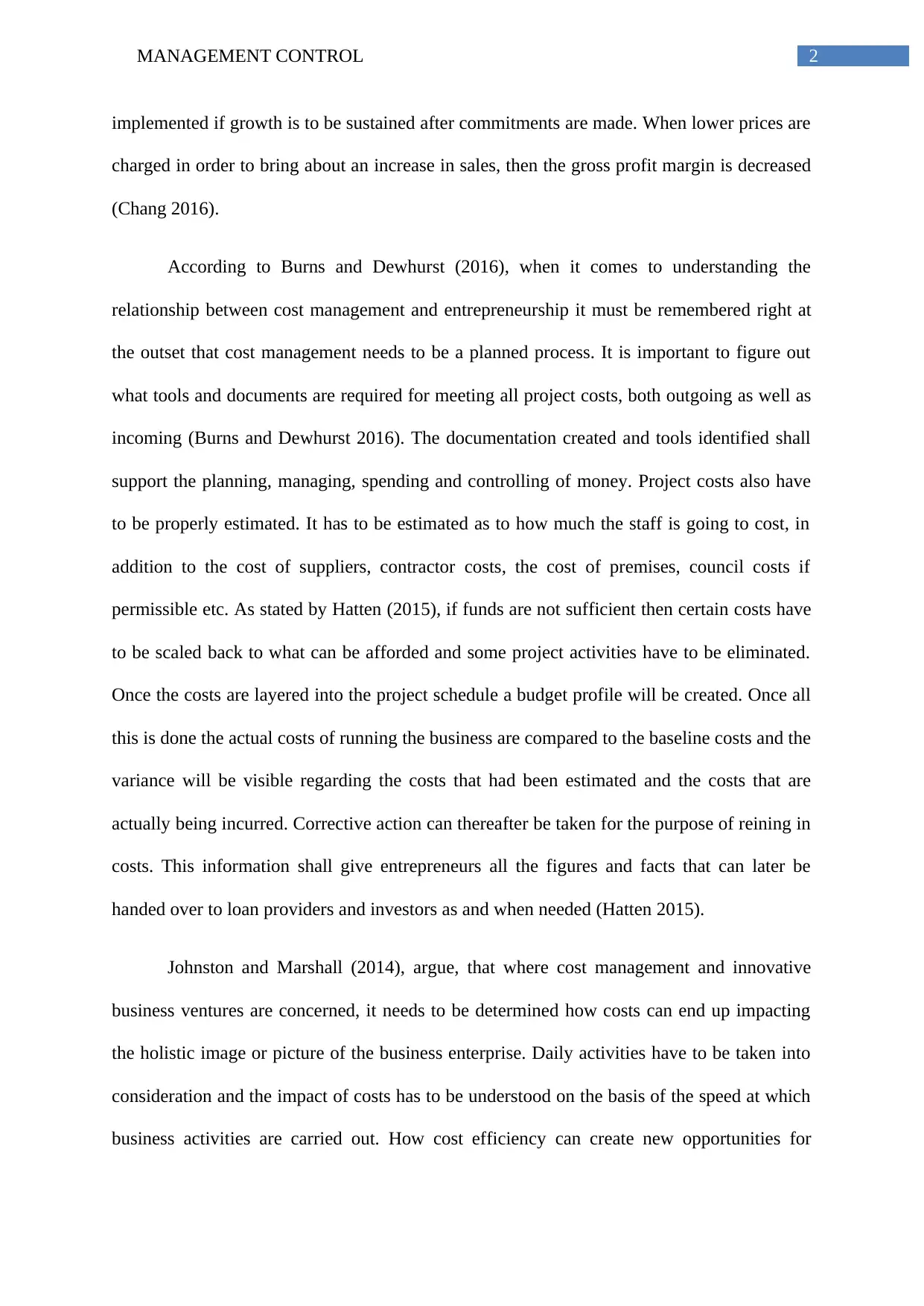
2MANAGEMENT CONTROL
implemented if growth is to be sustained after commitments are made. When lower prices are
charged in order to bring about an increase in sales, then the gross profit margin is decreased
(Chang 2016).
According to Burns and Dewhurst (2016), when it comes to understanding the
relationship between cost management and entrepreneurship it must be remembered right at
the outset that cost management needs to be a planned process. It is important to figure out
what tools and documents are required for meeting all project costs, both outgoing as well as
incoming (Burns and Dewhurst 2016). The documentation created and tools identified shall
support the planning, managing, spending and controlling of money. Project costs also have
to be properly estimated. It has to be estimated as to how much the staff is going to cost, in
addition to the cost of suppliers, contractor costs, the cost of premises, council costs if
permissible etc. As stated by Hatten (2015), if funds are not sufficient then certain costs have
to be scaled back to what can be afforded and some project activities have to be eliminated.
Once the costs are layered into the project schedule a budget profile will be created. Once all
this is done the actual costs of running the business are compared to the baseline costs and the
variance will be visible regarding the costs that had been estimated and the costs that are
actually being incurred. Corrective action can thereafter be taken for the purpose of reining in
costs. This information shall give entrepreneurs all the figures and facts that can later be
handed over to loan providers and investors as and when needed (Hatten 2015).
Johnston and Marshall (2014), argue, that where cost management and innovative
business ventures are concerned, it needs to be determined how costs can end up impacting
the holistic image or picture of the business enterprise. Daily activities have to be taken into
consideration and the impact of costs has to be understood on the basis of the speed at which
business activities are carried out. How cost efficiency can create new opportunities for
implemented if growth is to be sustained after commitments are made. When lower prices are
charged in order to bring about an increase in sales, then the gross profit margin is decreased
(Chang 2016).
According to Burns and Dewhurst (2016), when it comes to understanding the
relationship between cost management and entrepreneurship it must be remembered right at
the outset that cost management needs to be a planned process. It is important to figure out
what tools and documents are required for meeting all project costs, both outgoing as well as
incoming (Burns and Dewhurst 2016). The documentation created and tools identified shall
support the planning, managing, spending and controlling of money. Project costs also have
to be properly estimated. It has to be estimated as to how much the staff is going to cost, in
addition to the cost of suppliers, contractor costs, the cost of premises, council costs if
permissible etc. As stated by Hatten (2015), if funds are not sufficient then certain costs have
to be scaled back to what can be afforded and some project activities have to be eliminated.
Once the costs are layered into the project schedule a budget profile will be created. Once all
this is done the actual costs of running the business are compared to the baseline costs and the
variance will be visible regarding the costs that had been estimated and the costs that are
actually being incurred. Corrective action can thereafter be taken for the purpose of reining in
costs. This information shall give entrepreneurs all the figures and facts that can later be
handed over to loan providers and investors as and when needed (Hatten 2015).
Johnston and Marshall (2014), argue, that where cost management and innovative
business ventures are concerned, it needs to be determined how costs can end up impacting
the holistic image or picture of the business enterprise. Daily activities have to be taken into
consideration and the impact of costs has to be understood on the basis of the speed at which
business activities are carried out. How cost efficiency can create new opportunities for
⊘ This is a preview!⊘
Do you want full access?
Subscribe today to unlock all pages.

Trusted by 1+ million students worldwide
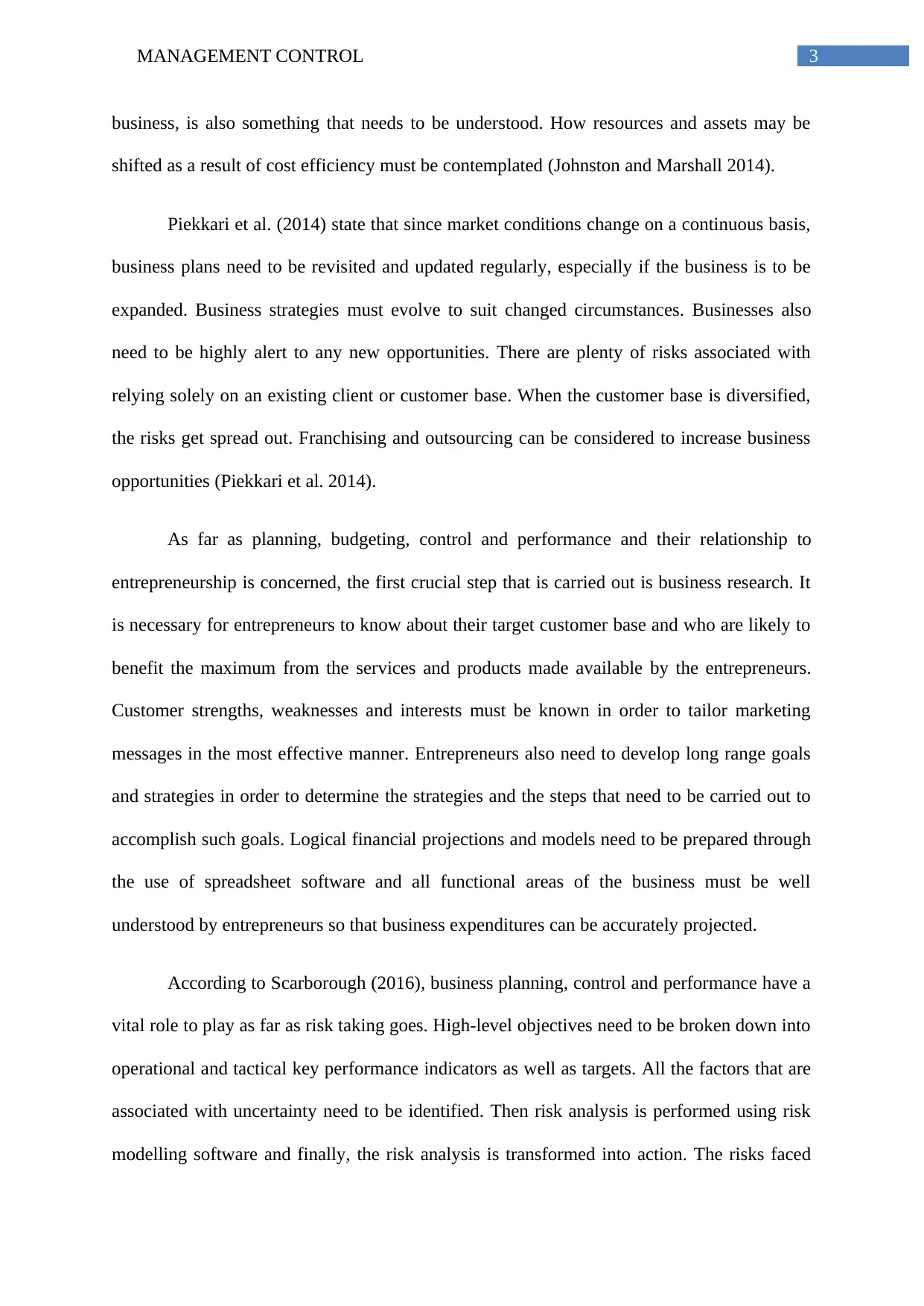
3MANAGEMENT CONTROL
business, is also something that needs to be understood. How resources and assets may be
shifted as a result of cost efficiency must be contemplated (Johnston and Marshall 2014).
Piekkari et al. (2014) state that since market conditions change on a continuous basis,
business plans need to be revisited and updated regularly, especially if the business is to be
expanded. Business strategies must evolve to suit changed circumstances. Businesses also
need to be highly alert to any new opportunities. There are plenty of risks associated with
relying solely on an existing client or customer base. When the customer base is diversified,
the risks get spread out. Franchising and outsourcing can be considered to increase business
opportunities (Piekkari et al. 2014).
As far as planning, budgeting, control and performance and their relationship to
entrepreneurship is concerned, the first crucial step that is carried out is business research. It
is necessary for entrepreneurs to know about their target customer base and who are likely to
benefit the maximum from the services and products made available by the entrepreneurs.
Customer strengths, weaknesses and interests must be known in order to tailor marketing
messages in the most effective manner. Entrepreneurs also need to develop long range goals
and strategies in order to determine the strategies and the steps that need to be carried out to
accomplish such goals. Logical financial projections and models need to be prepared through
the use of spreadsheet software and all functional areas of the business must be well
understood by entrepreneurs so that business expenditures can be accurately projected.
According to Scarborough (2016), business planning, control and performance have a
vital role to play as far as risk taking goes. High-level objectives need to be broken down into
operational and tactical key performance indicators as well as targets. All the factors that are
associated with uncertainty need to be identified. Then risk analysis is performed using risk
modelling software and finally, the risk analysis is transformed into action. The risks faced
business, is also something that needs to be understood. How resources and assets may be
shifted as a result of cost efficiency must be contemplated (Johnston and Marshall 2014).
Piekkari et al. (2014) state that since market conditions change on a continuous basis,
business plans need to be revisited and updated regularly, especially if the business is to be
expanded. Business strategies must evolve to suit changed circumstances. Businesses also
need to be highly alert to any new opportunities. There are plenty of risks associated with
relying solely on an existing client or customer base. When the customer base is diversified,
the risks get spread out. Franchising and outsourcing can be considered to increase business
opportunities (Piekkari et al. 2014).
As far as planning, budgeting, control and performance and their relationship to
entrepreneurship is concerned, the first crucial step that is carried out is business research. It
is necessary for entrepreneurs to know about their target customer base and who are likely to
benefit the maximum from the services and products made available by the entrepreneurs.
Customer strengths, weaknesses and interests must be known in order to tailor marketing
messages in the most effective manner. Entrepreneurs also need to develop long range goals
and strategies in order to determine the strategies and the steps that need to be carried out to
accomplish such goals. Logical financial projections and models need to be prepared through
the use of spreadsheet software and all functional areas of the business must be well
understood by entrepreneurs so that business expenditures can be accurately projected.
According to Scarborough (2016), business planning, control and performance have a
vital role to play as far as risk taking goes. High-level objectives need to be broken down into
operational and tactical key performance indicators as well as targets. All the factors that are
associated with uncertainty need to be identified. Then risk analysis is performed using risk
modelling software and finally, the risk analysis is transformed into action. The risks faced
Paraphrase This Document
Need a fresh take? Get an instant paraphrase of this document with our AI Paraphraser
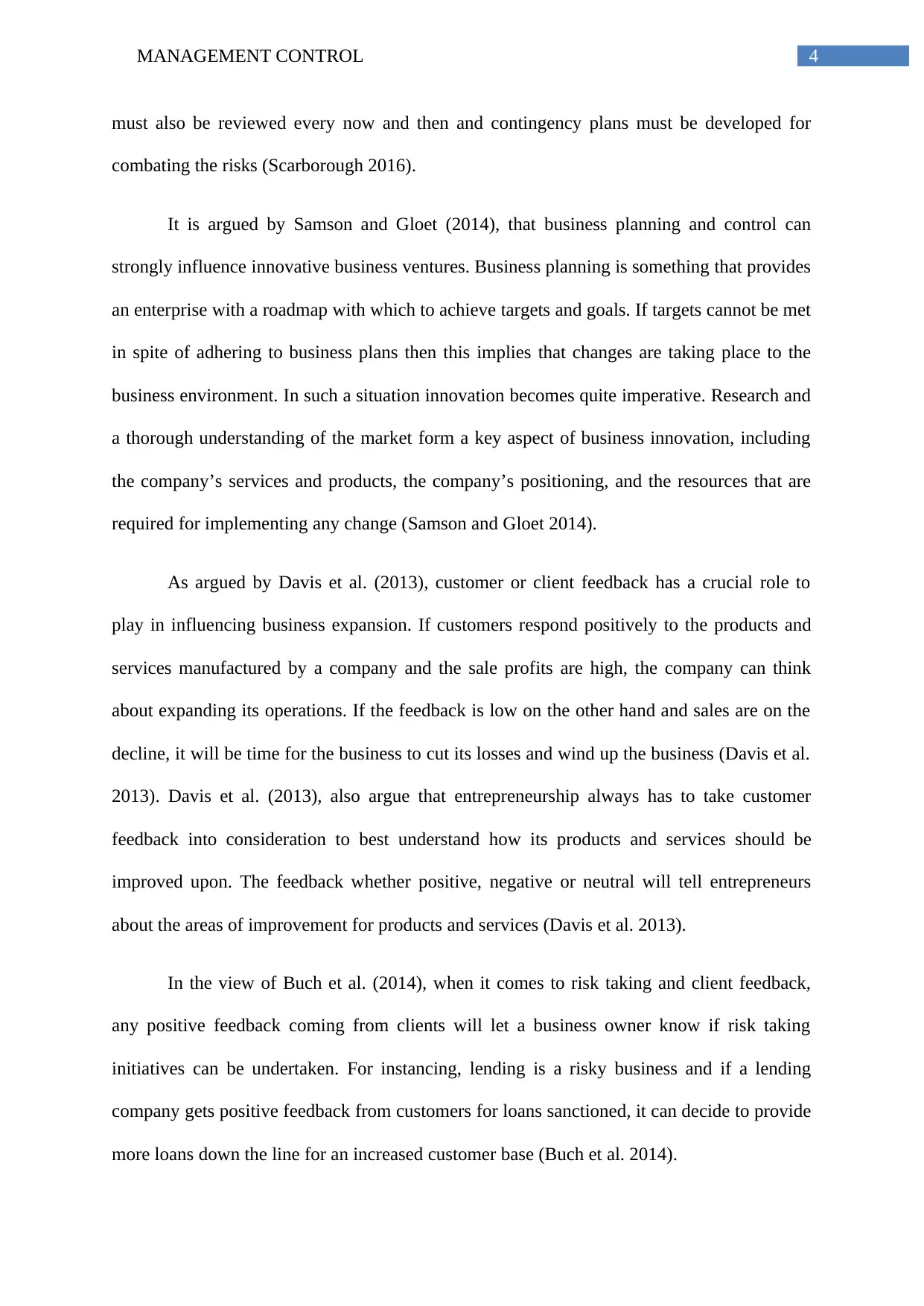
4MANAGEMENT CONTROL
must also be reviewed every now and then and contingency plans must be developed for
combating the risks (Scarborough 2016).
It is argued by Samson and Gloet (2014), that business planning and control can
strongly influence innovative business ventures. Business planning is something that provides
an enterprise with a roadmap with which to achieve targets and goals. If targets cannot be met
in spite of adhering to business plans then this implies that changes are taking place to the
business environment. In such a situation innovation becomes quite imperative. Research and
a thorough understanding of the market form a key aspect of business innovation, including
the company’s services and products, the company’s positioning, and the resources that are
required for implementing any change (Samson and Gloet 2014).
As argued by Davis et al. (2013), customer or client feedback has a crucial role to
play in influencing business expansion. If customers respond positively to the products and
services manufactured by a company and the sale profits are high, the company can think
about expanding its operations. If the feedback is low on the other hand and sales are on the
decline, it will be time for the business to cut its losses and wind up the business (Davis et al.
2013). Davis et al. (2013), also argue that entrepreneurship always has to take customer
feedback into consideration to best understand how its products and services should be
improved upon. The feedback whether positive, negative or neutral will tell entrepreneurs
about the areas of improvement for products and services (Davis et al. 2013).
In the view of Buch et al. (2014), when it comes to risk taking and client feedback,
any positive feedback coming from clients will let a business owner know if risk taking
initiatives can be undertaken. For instancing, lending is a risky business and if a lending
company gets positive feedback from customers for loans sanctioned, it can decide to provide
more loans down the line for an increased customer base (Buch et al. 2014).
must also be reviewed every now and then and contingency plans must be developed for
combating the risks (Scarborough 2016).
It is argued by Samson and Gloet (2014), that business planning and control can
strongly influence innovative business ventures. Business planning is something that provides
an enterprise with a roadmap with which to achieve targets and goals. If targets cannot be met
in spite of adhering to business plans then this implies that changes are taking place to the
business environment. In such a situation innovation becomes quite imperative. Research and
a thorough understanding of the market form a key aspect of business innovation, including
the company’s services and products, the company’s positioning, and the resources that are
required for implementing any change (Samson and Gloet 2014).
As argued by Davis et al. (2013), customer or client feedback has a crucial role to
play in influencing business expansion. If customers respond positively to the products and
services manufactured by a company and the sale profits are high, the company can think
about expanding its operations. If the feedback is low on the other hand and sales are on the
decline, it will be time for the business to cut its losses and wind up the business (Davis et al.
2013). Davis et al. (2013), also argue that entrepreneurship always has to take customer
feedback into consideration to best understand how its products and services should be
improved upon. The feedback whether positive, negative or neutral will tell entrepreneurs
about the areas of improvement for products and services (Davis et al. 2013).
In the view of Buch et al. (2014), when it comes to risk taking and client feedback,
any positive feedback coming from clients will let a business owner know if risk taking
initiatives can be undertaken. For instancing, lending is a risky business and if a lending
company gets positive feedback from customers for loans sanctioned, it can decide to provide
more loans down the line for an increased customer base (Buch et al. 2014).
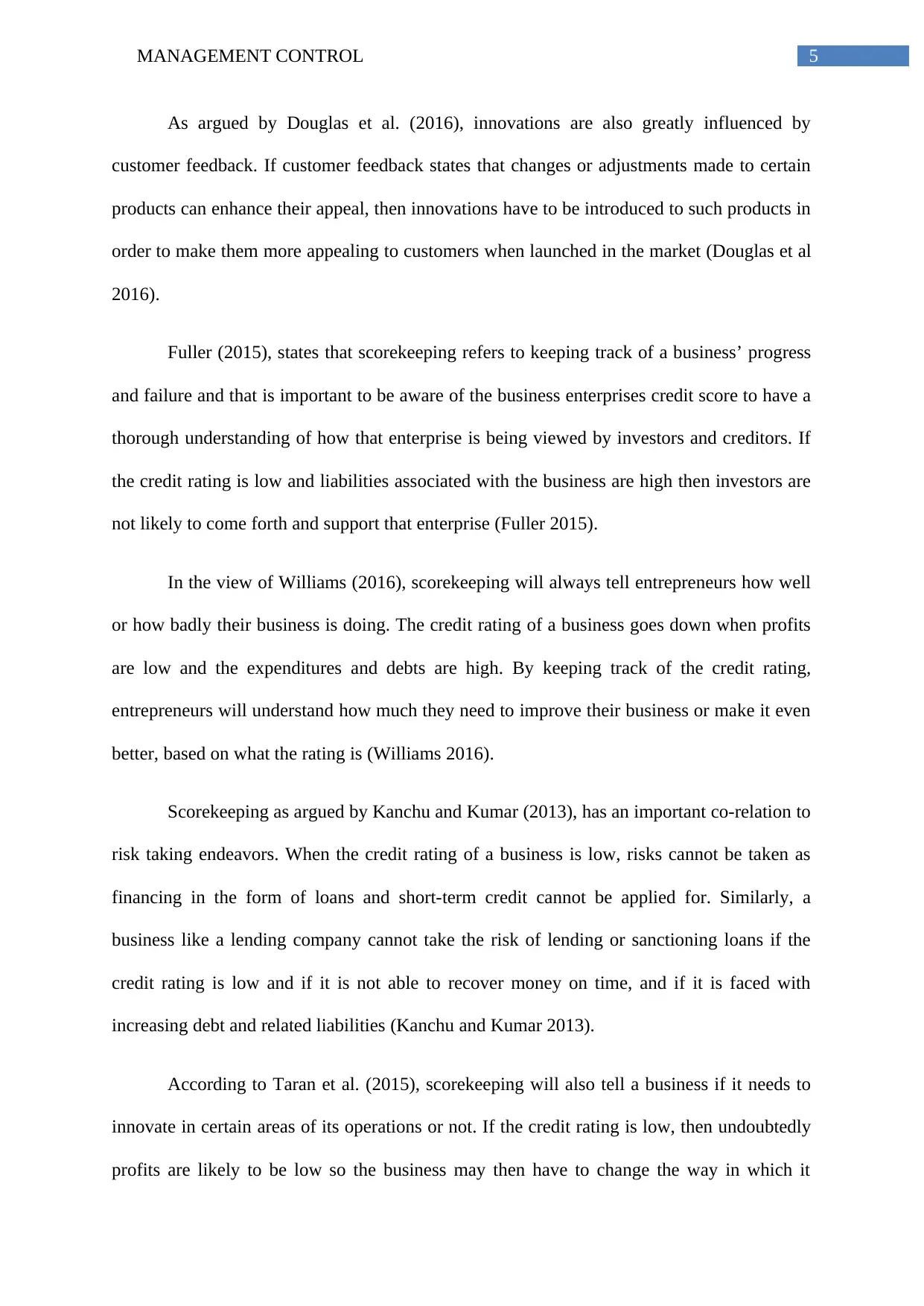
5MANAGEMENT CONTROL
As argued by Douglas et al. (2016), innovations are also greatly influenced by
customer feedback. If customer feedback states that changes or adjustments made to certain
products can enhance their appeal, then innovations have to be introduced to such products in
order to make them more appealing to customers when launched in the market (Douglas et al
2016).
Fuller (2015), states that scorekeeping refers to keeping track of a business’ progress
and failure and that is important to be aware of the business enterprises credit score to have a
thorough understanding of how that enterprise is being viewed by investors and creditors. If
the credit rating is low and liabilities associated with the business are high then investors are
not likely to come forth and support that enterprise (Fuller 2015).
In the view of Williams (2016), scorekeeping will always tell entrepreneurs how well
or how badly their business is doing. The credit rating of a business goes down when profits
are low and the expenditures and debts are high. By keeping track of the credit rating,
entrepreneurs will understand how much they need to improve their business or make it even
better, based on what the rating is (Williams 2016).
Scorekeeping as argued by Kanchu and Kumar (2013), has an important co-relation to
risk taking endeavors. When the credit rating of a business is low, risks cannot be taken as
financing in the form of loans and short-term credit cannot be applied for. Similarly, a
business like a lending company cannot take the risk of lending or sanctioning loans if the
credit rating is low and if it is not able to recover money on time, and if it is faced with
increasing debt and related liabilities (Kanchu and Kumar 2013).
According to Taran et al. (2015), scorekeeping will also tell a business if it needs to
innovate in certain areas of its operations or not. If the credit rating is low, then undoubtedly
profits are likely to be low so the business may then have to change the way in which it
As argued by Douglas et al. (2016), innovations are also greatly influenced by
customer feedback. If customer feedback states that changes or adjustments made to certain
products can enhance their appeal, then innovations have to be introduced to such products in
order to make them more appealing to customers when launched in the market (Douglas et al
2016).
Fuller (2015), states that scorekeeping refers to keeping track of a business’ progress
and failure and that is important to be aware of the business enterprises credit score to have a
thorough understanding of how that enterprise is being viewed by investors and creditors. If
the credit rating is low and liabilities associated with the business are high then investors are
not likely to come forth and support that enterprise (Fuller 2015).
In the view of Williams (2016), scorekeeping will always tell entrepreneurs how well
or how badly their business is doing. The credit rating of a business goes down when profits
are low and the expenditures and debts are high. By keeping track of the credit rating,
entrepreneurs will understand how much they need to improve their business or make it even
better, based on what the rating is (Williams 2016).
Scorekeeping as argued by Kanchu and Kumar (2013), has an important co-relation to
risk taking endeavors. When the credit rating of a business is low, risks cannot be taken as
financing in the form of loans and short-term credit cannot be applied for. Similarly, a
business like a lending company cannot take the risk of lending or sanctioning loans if the
credit rating is low and if it is not able to recover money on time, and if it is faced with
increasing debt and related liabilities (Kanchu and Kumar 2013).
According to Taran et al. (2015), scorekeeping will also tell a business if it needs to
innovate in certain areas of its operations or not. If the credit rating is low, then undoubtedly
profits are likely to be low so the business may then have to change the way in which it
⊘ This is a preview!⊘
Do you want full access?
Subscribe today to unlock all pages.

Trusted by 1+ million students worldwide
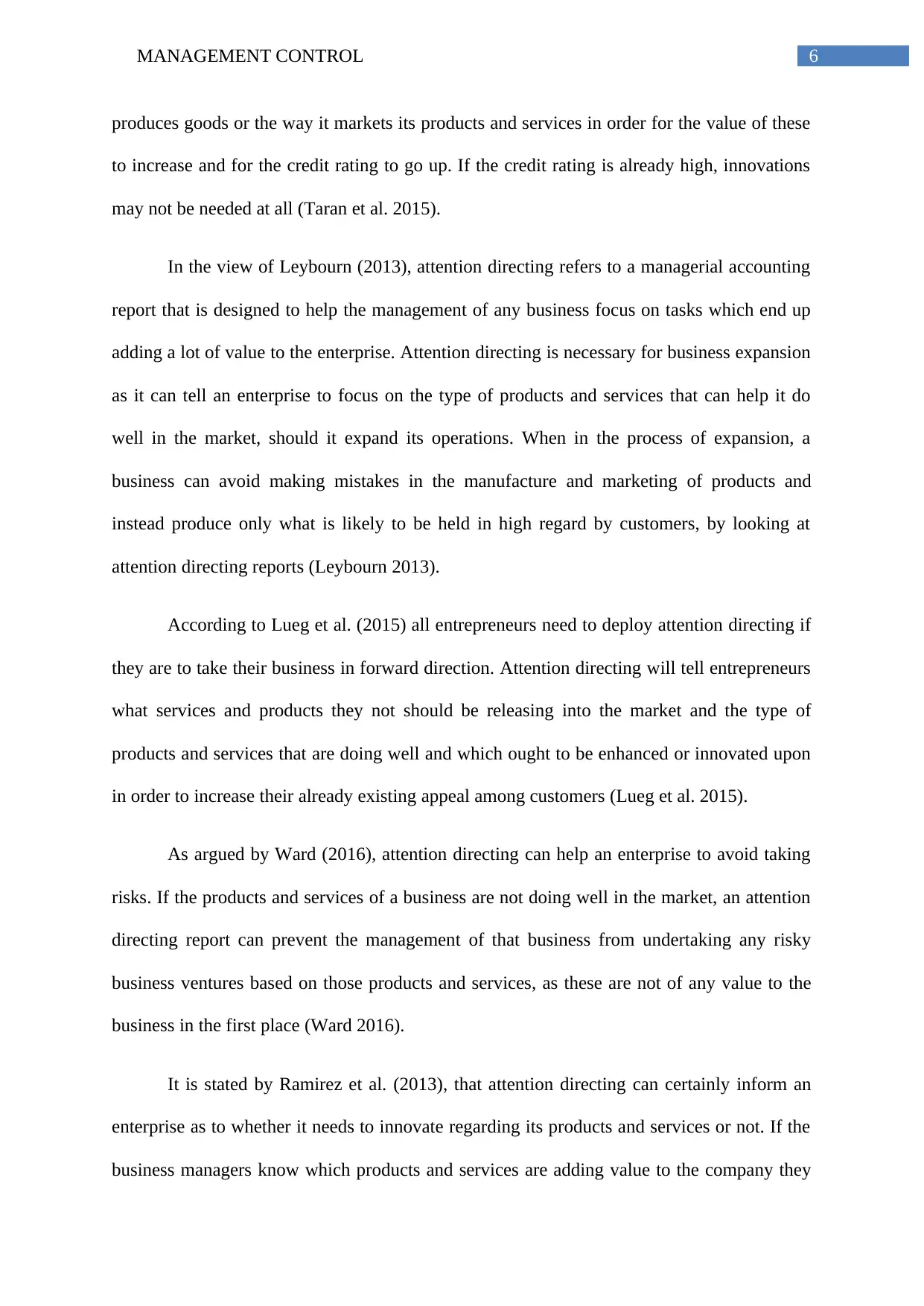
6MANAGEMENT CONTROL
produces goods or the way it markets its products and services in order for the value of these
to increase and for the credit rating to go up. If the credit rating is already high, innovations
may not be needed at all (Taran et al. 2015).
In the view of Leybourn (2013), attention directing refers to a managerial accounting
report that is designed to help the management of any business focus on tasks which end up
adding a lot of value to the enterprise. Attention directing is necessary for business expansion
as it can tell an enterprise to focus on the type of products and services that can help it do
well in the market, should it expand its operations. When in the process of expansion, a
business can avoid making mistakes in the manufacture and marketing of products and
instead produce only what is likely to be held in high regard by customers, by looking at
attention directing reports (Leybourn 2013).
According to Lueg et al. (2015) all entrepreneurs need to deploy attention directing if
they are to take their business in forward direction. Attention directing will tell entrepreneurs
what services and products they not should be releasing into the market and the type of
products and services that are doing well and which ought to be enhanced or innovated upon
in order to increase their already existing appeal among customers (Lueg et al. 2015).
As argued by Ward (2016), attention directing can help an enterprise to avoid taking
risks. If the products and services of a business are not doing well in the market, an attention
directing report can prevent the management of that business from undertaking any risky
business ventures based on those products and services, as these are not of any value to the
business in the first place (Ward 2016).
It is stated by Ramirez et al. (2013), that attention directing can certainly inform an
enterprise as to whether it needs to innovate regarding its products and services or not. If the
business managers know which products and services are adding value to the company they
produces goods or the way it markets its products and services in order for the value of these
to increase and for the credit rating to go up. If the credit rating is already high, innovations
may not be needed at all (Taran et al. 2015).
In the view of Leybourn (2013), attention directing refers to a managerial accounting
report that is designed to help the management of any business focus on tasks which end up
adding a lot of value to the enterprise. Attention directing is necessary for business expansion
as it can tell an enterprise to focus on the type of products and services that can help it do
well in the market, should it expand its operations. When in the process of expansion, a
business can avoid making mistakes in the manufacture and marketing of products and
instead produce only what is likely to be held in high regard by customers, by looking at
attention directing reports (Leybourn 2013).
According to Lueg et al. (2015) all entrepreneurs need to deploy attention directing if
they are to take their business in forward direction. Attention directing will tell entrepreneurs
what services and products they not should be releasing into the market and the type of
products and services that are doing well and which ought to be enhanced or innovated upon
in order to increase their already existing appeal among customers (Lueg et al. 2015).
As argued by Ward (2016), attention directing can help an enterprise to avoid taking
risks. If the products and services of a business are not doing well in the market, an attention
directing report can prevent the management of that business from undertaking any risky
business ventures based on those products and services, as these are not of any value to the
business in the first place (Ward 2016).
It is stated by Ramirez et al. (2013), that attention directing can certainly inform an
enterprise as to whether it needs to innovate regarding its products and services or not. If the
business managers know which products and services are adding value to the company they
Paraphrase This Document
Need a fresh take? Get an instant paraphrase of this document with our AI Paraphraser
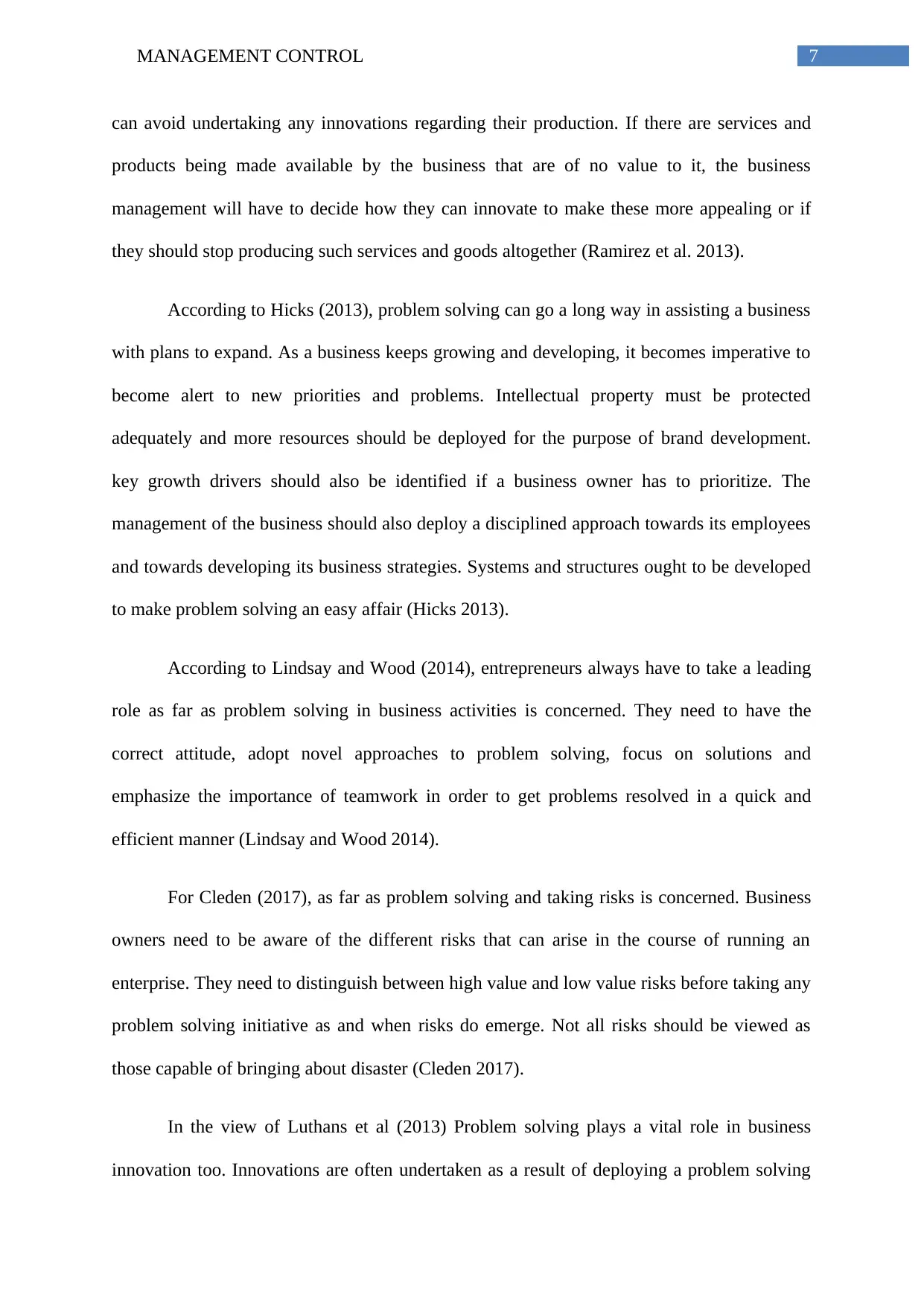
7MANAGEMENT CONTROL
can avoid undertaking any innovations regarding their production. If there are services and
products being made available by the business that are of no value to it, the business
management will have to decide how they can innovate to make these more appealing or if
they should stop producing such services and goods altogether (Ramirez et al. 2013).
According to Hicks (2013), problem solving can go a long way in assisting a business
with plans to expand. As a business keeps growing and developing, it becomes imperative to
become alert to new priorities and problems. Intellectual property must be protected
adequately and more resources should be deployed for the purpose of brand development.
key growth drivers should also be identified if a business owner has to prioritize. The
management of the business should also deploy a disciplined approach towards its employees
and towards developing its business strategies. Systems and structures ought to be developed
to make problem solving an easy affair (Hicks 2013).
According to Lindsay and Wood (2014), entrepreneurs always have to take a leading
role as far as problem solving in business activities is concerned. They need to have the
correct attitude, adopt novel approaches to problem solving, focus on solutions and
emphasize the importance of teamwork in order to get problems resolved in a quick and
efficient manner (Lindsay and Wood 2014).
For Cleden (2017), as far as problem solving and taking risks is concerned. Business
owners need to be aware of the different risks that can arise in the course of running an
enterprise. They need to distinguish between high value and low value risks before taking any
problem solving initiative as and when risks do emerge. Not all risks should be viewed as
those capable of bringing about disaster (Cleden 2017).
In the view of Luthans et al (2013) Problem solving plays a vital role in business
innovation too. Innovations are often undertaken as a result of deploying a problem solving
can avoid undertaking any innovations regarding their production. If there are services and
products being made available by the business that are of no value to it, the business
management will have to decide how they can innovate to make these more appealing or if
they should stop producing such services and goods altogether (Ramirez et al. 2013).
According to Hicks (2013), problem solving can go a long way in assisting a business
with plans to expand. As a business keeps growing and developing, it becomes imperative to
become alert to new priorities and problems. Intellectual property must be protected
adequately and more resources should be deployed for the purpose of brand development.
key growth drivers should also be identified if a business owner has to prioritize. The
management of the business should also deploy a disciplined approach towards its employees
and towards developing its business strategies. Systems and structures ought to be developed
to make problem solving an easy affair (Hicks 2013).
According to Lindsay and Wood (2014), entrepreneurs always have to take a leading
role as far as problem solving in business activities is concerned. They need to have the
correct attitude, adopt novel approaches to problem solving, focus on solutions and
emphasize the importance of teamwork in order to get problems resolved in a quick and
efficient manner (Lindsay and Wood 2014).
For Cleden (2017), as far as problem solving and taking risks is concerned. Business
owners need to be aware of the different risks that can arise in the course of running an
enterprise. They need to distinguish between high value and low value risks before taking any
problem solving initiative as and when risks do emerge. Not all risks should be viewed as
those capable of bringing about disaster (Cleden 2017).
In the view of Luthans et al (2013) Problem solving plays a vital role in business
innovation too. Innovations are often undertaken as a result of deploying a problem solving
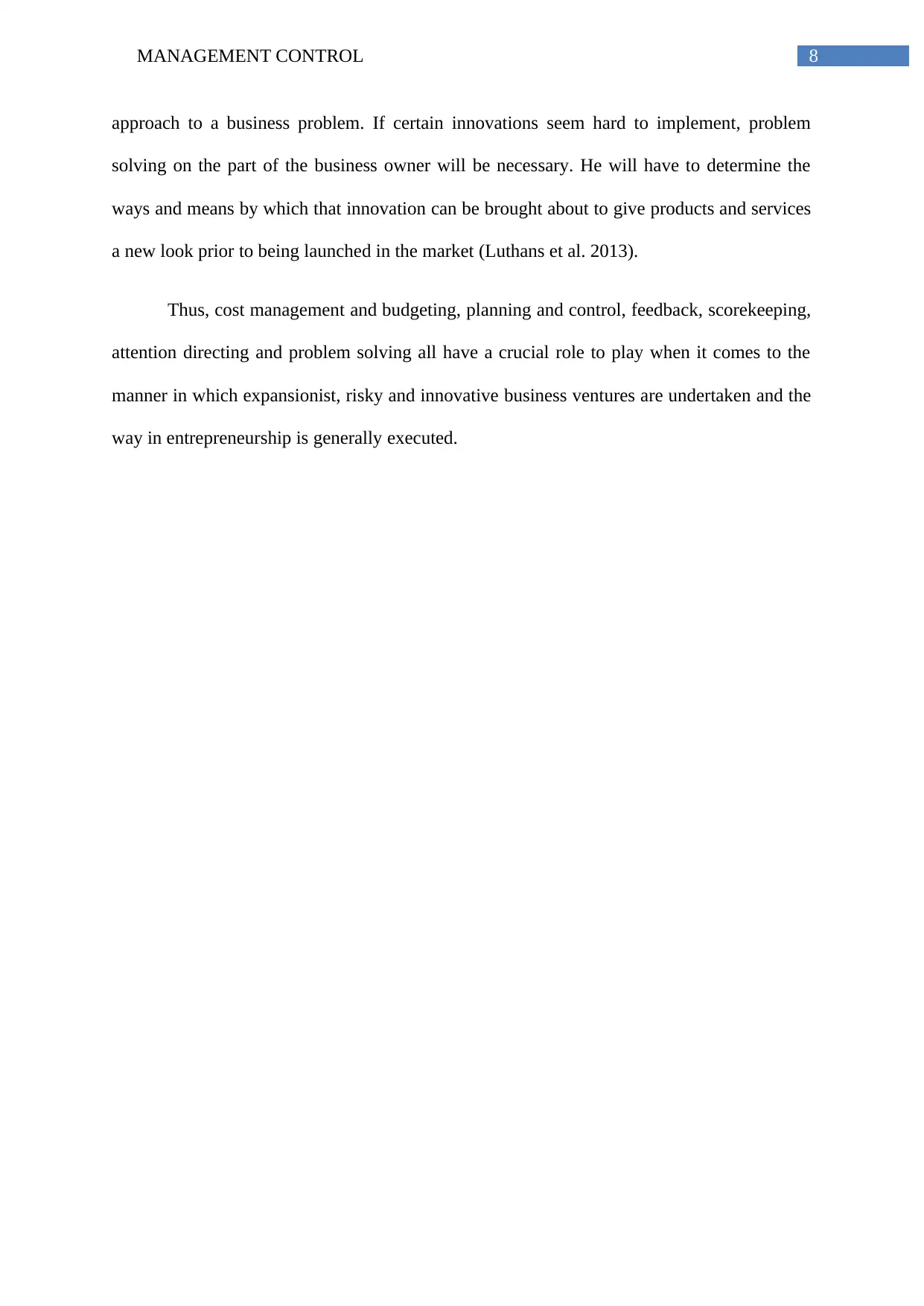
8MANAGEMENT CONTROL
approach to a business problem. If certain innovations seem hard to implement, problem
solving on the part of the business owner will be necessary. He will have to determine the
ways and means by which that innovation can be brought about to give products and services
a new look prior to being launched in the market (Luthans et al. 2013).
Thus, cost management and budgeting, planning and control, feedback, scorekeeping,
attention directing and problem solving all have a crucial role to play when it comes to the
manner in which expansionist, risky and innovative business ventures are undertaken and the
way in entrepreneurship is generally executed.
approach to a business problem. If certain innovations seem hard to implement, problem
solving on the part of the business owner will be necessary. He will have to determine the
ways and means by which that innovation can be brought about to give products and services
a new look prior to being launched in the market (Luthans et al. 2013).
Thus, cost management and budgeting, planning and control, feedback, scorekeeping,
attention directing and problem solving all have a crucial role to play when it comes to the
manner in which expansionist, risky and innovative business ventures are undertaken and the
way in entrepreneurship is generally executed.
⊘ This is a preview!⊘
Do you want full access?
Subscribe today to unlock all pages.

Trusted by 1+ million students worldwide
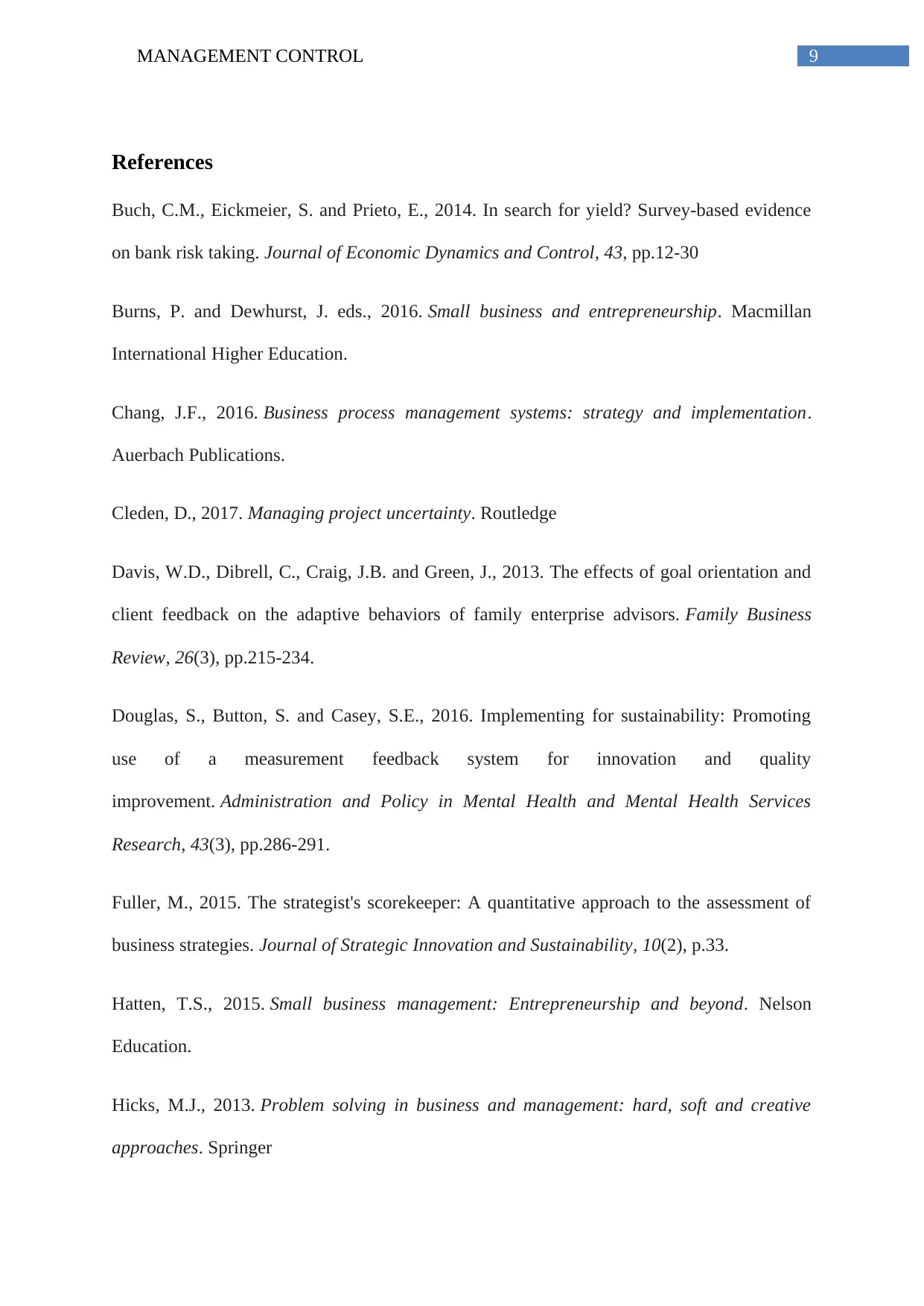
9MANAGEMENT CONTROL
References
Buch, C.M., Eickmeier, S. and Prieto, E., 2014. In search for yield? Survey-based evidence
on bank risk taking. Journal of Economic Dynamics and Control, 43, pp.12-30
Burns, P. and Dewhurst, J. eds., 2016. Small business and entrepreneurship. Macmillan
International Higher Education.
Chang, J.F., 2016. Business process management systems: strategy and implementation.
Auerbach Publications.
Cleden, D., 2017. Managing project uncertainty. Routledge
Davis, W.D., Dibrell, C., Craig, J.B. and Green, J., 2013. The effects of goal orientation and
client feedback on the adaptive behaviors of family enterprise advisors. Family Business
Review, 26(3), pp.215-234.
Douglas, S., Button, S. and Casey, S.E., 2016. Implementing for sustainability: Promoting
use of a measurement feedback system for innovation and quality
improvement. Administration and Policy in Mental Health and Mental Health Services
Research, 43(3), pp.286-291.
Fuller, M., 2015. The strategist's scorekeeper: A quantitative approach to the assessment of
business strategies. Journal of Strategic Innovation and Sustainability, 10(2), p.33.
Hatten, T.S., 2015. Small business management: Entrepreneurship and beyond. Nelson
Education.
Hicks, M.J., 2013. Problem solving in business and management: hard, soft and creative
approaches. Springer
References
Buch, C.M., Eickmeier, S. and Prieto, E., 2014. In search for yield? Survey-based evidence
on bank risk taking. Journal of Economic Dynamics and Control, 43, pp.12-30
Burns, P. and Dewhurst, J. eds., 2016. Small business and entrepreneurship. Macmillan
International Higher Education.
Chang, J.F., 2016. Business process management systems: strategy and implementation.
Auerbach Publications.
Cleden, D., 2017. Managing project uncertainty. Routledge
Davis, W.D., Dibrell, C., Craig, J.B. and Green, J., 2013. The effects of goal orientation and
client feedback on the adaptive behaviors of family enterprise advisors. Family Business
Review, 26(3), pp.215-234.
Douglas, S., Button, S. and Casey, S.E., 2016. Implementing for sustainability: Promoting
use of a measurement feedback system for innovation and quality
improvement. Administration and Policy in Mental Health and Mental Health Services
Research, 43(3), pp.286-291.
Fuller, M., 2015. The strategist's scorekeeper: A quantitative approach to the assessment of
business strategies. Journal of Strategic Innovation and Sustainability, 10(2), p.33.
Hatten, T.S., 2015. Small business management: Entrepreneurship and beyond. Nelson
Education.
Hicks, M.J., 2013. Problem solving in business and management: hard, soft and creative
approaches. Springer
Paraphrase This Document
Need a fresh take? Get an instant paraphrase of this document with our AI Paraphraser
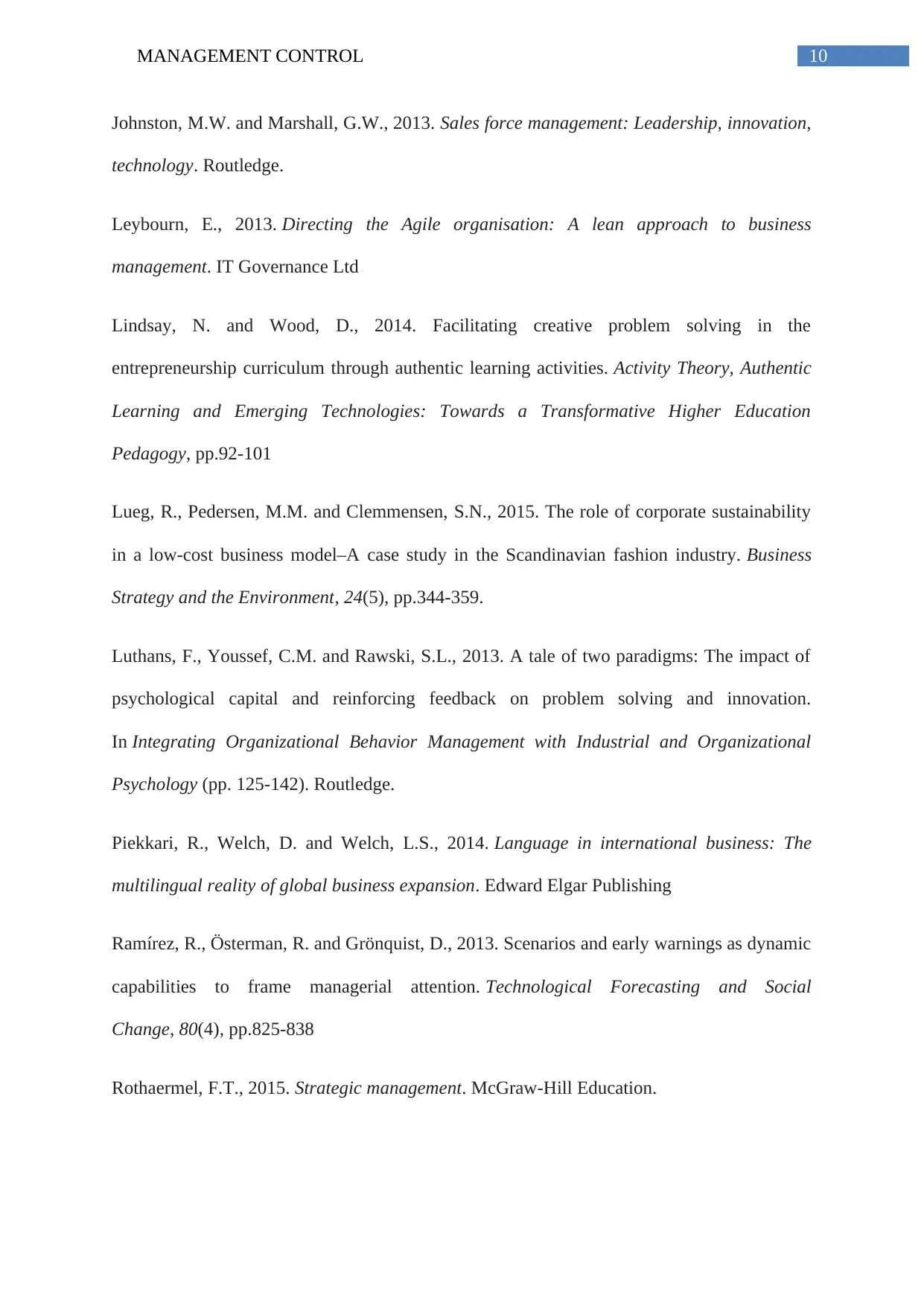
10MANAGEMENT CONTROL
Johnston, M.W. and Marshall, G.W., 2013. Sales force management: Leadership, innovation,
technology. Routledge.
Leybourn, E., 2013. Directing the Agile organisation: A lean approach to business
management. IT Governance Ltd
Lindsay, N. and Wood, D., 2014. Facilitating creative problem solving in the
entrepreneurship curriculum through authentic learning activities. Activity Theory, Authentic
Learning and Emerging Technologies: Towards a Transformative Higher Education
Pedagogy, pp.92-101
Lueg, R., Pedersen, M.M. and Clemmensen, S.N., 2015. The role of corporate sustainability
in a low‐cost business model–A case study in the Scandinavian fashion industry. Business
Strategy and the Environment, 24(5), pp.344-359.
Luthans, F., Youssef, C.M. and Rawski, S.L., 2013. A tale of two paradigms: The impact of
psychological capital and reinforcing feedback on problem solving and innovation.
In Integrating Organizational Behavior Management with Industrial and Organizational
Psychology (pp. 125-142). Routledge.
Piekkari, R., Welch, D. and Welch, L.S., 2014. Language in international business: The
multilingual reality of global business expansion. Edward Elgar Publishing
Ramírez, R., Österman, R. and Grönquist, D., 2013. Scenarios and early warnings as dynamic
capabilities to frame managerial attention. Technological Forecasting and Social
Change, 80(4), pp.825-838
Rothaermel, F.T., 2015. Strategic management. McGraw-Hill Education.
Johnston, M.W. and Marshall, G.W., 2013. Sales force management: Leadership, innovation,
technology. Routledge.
Leybourn, E., 2013. Directing the Agile organisation: A lean approach to business
management. IT Governance Ltd
Lindsay, N. and Wood, D., 2014. Facilitating creative problem solving in the
entrepreneurship curriculum through authentic learning activities. Activity Theory, Authentic
Learning and Emerging Technologies: Towards a Transformative Higher Education
Pedagogy, pp.92-101
Lueg, R., Pedersen, M.M. and Clemmensen, S.N., 2015. The role of corporate sustainability
in a low‐cost business model–A case study in the Scandinavian fashion industry. Business
Strategy and the Environment, 24(5), pp.344-359.
Luthans, F., Youssef, C.M. and Rawski, S.L., 2013. A tale of two paradigms: The impact of
psychological capital and reinforcing feedback on problem solving and innovation.
In Integrating Organizational Behavior Management with Industrial and Organizational
Psychology (pp. 125-142). Routledge.
Piekkari, R., Welch, D. and Welch, L.S., 2014. Language in international business: The
multilingual reality of global business expansion. Edward Elgar Publishing
Ramírez, R., Österman, R. and Grönquist, D., 2013. Scenarios and early warnings as dynamic
capabilities to frame managerial attention. Technological Forecasting and Social
Change, 80(4), pp.825-838
Rothaermel, F.T., 2015. Strategic management. McGraw-Hill Education.
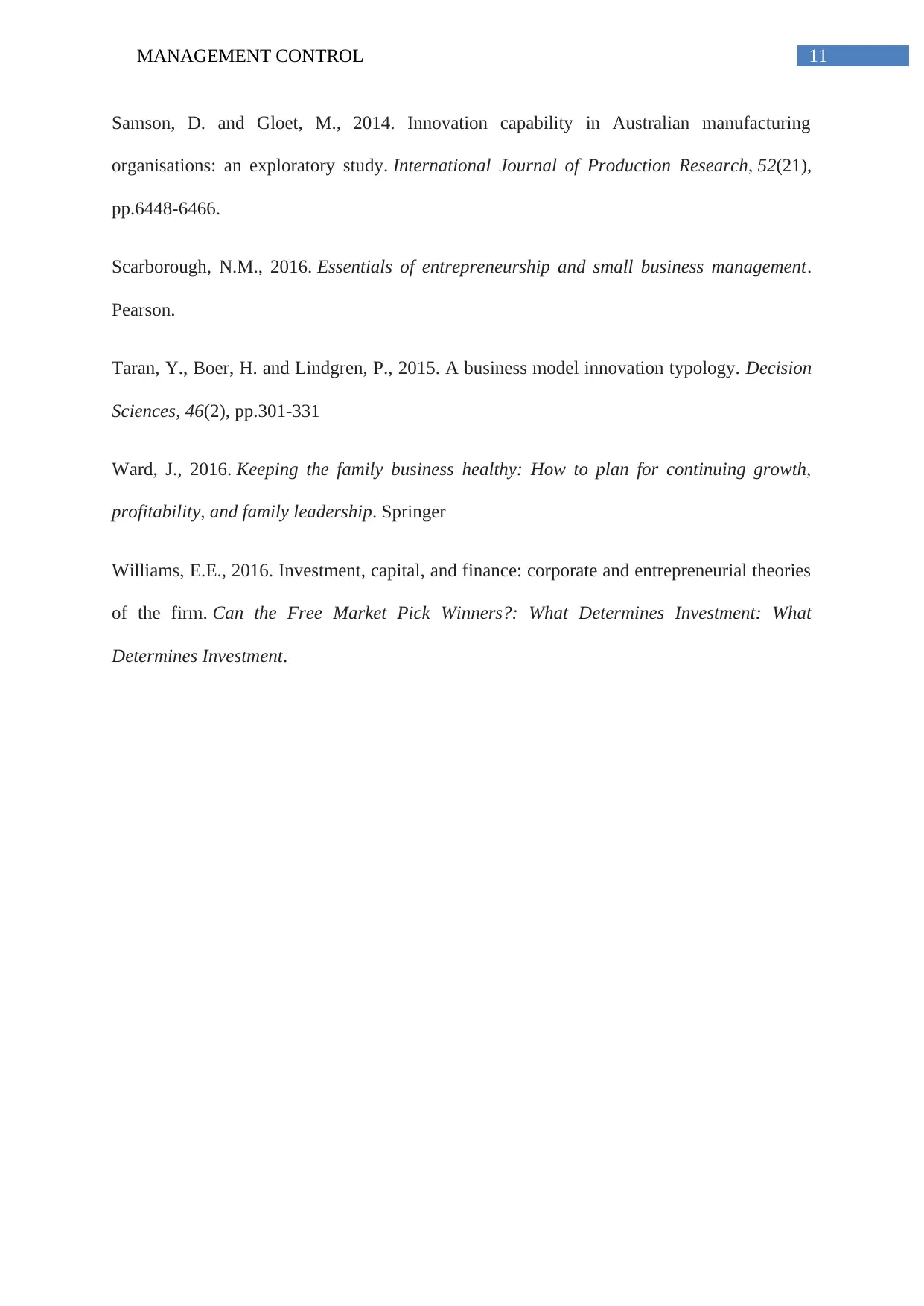
11MANAGEMENT CONTROL
Samson, D. and Gloet, M., 2014. Innovation capability in Australian manufacturing
organisations: an exploratory study. International Journal of Production Research, 52(21),
pp.6448-6466.
Scarborough, N.M., 2016. Essentials of entrepreneurship and small business management.
Pearson.
Taran, Y., Boer, H. and Lindgren, P., 2015. A business model innovation typology. Decision
Sciences, 46(2), pp.301-331
Ward, J., 2016. Keeping the family business healthy: How to plan for continuing growth,
profitability, and family leadership. Springer
Williams, E.E., 2016. Investment, capital, and finance: corporate and entrepreneurial theories
of the firm. Can the Free Market Pick Winners?: What Determines Investment: What
Determines Investment.
Samson, D. and Gloet, M., 2014. Innovation capability in Australian manufacturing
organisations: an exploratory study. International Journal of Production Research, 52(21),
pp.6448-6466.
Scarborough, N.M., 2016. Essentials of entrepreneurship and small business management.
Pearson.
Taran, Y., Boer, H. and Lindgren, P., 2015. A business model innovation typology. Decision
Sciences, 46(2), pp.301-331
Ward, J., 2016. Keeping the family business healthy: How to plan for continuing growth,
profitability, and family leadership. Springer
Williams, E.E., 2016. Investment, capital, and finance: corporate and entrepreneurial theories
of the firm. Can the Free Market Pick Winners?: What Determines Investment: What
Determines Investment.
⊘ This is a preview!⊘
Do you want full access?
Subscribe today to unlock all pages.

Trusted by 1+ million students worldwide
1 out of 12
Related Documents
Your All-in-One AI-Powered Toolkit for Academic Success.
+13062052269
info@desklib.com
Available 24*7 on WhatsApp / Email
![[object Object]](/_next/static/media/star-bottom.7253800d.svg)
Unlock your academic potential
© 2024 | Zucol Services PVT LTD | All rights reserved.





